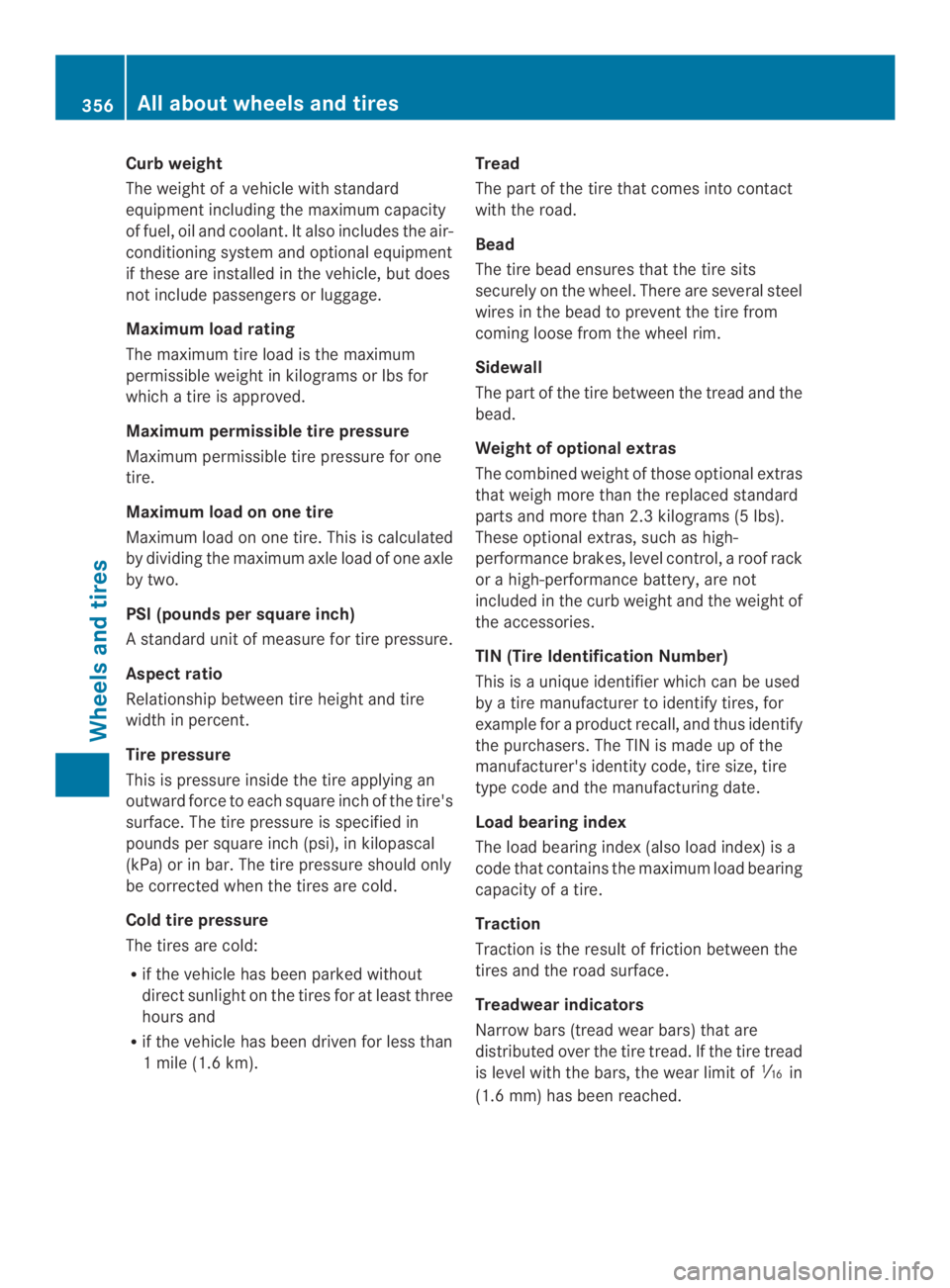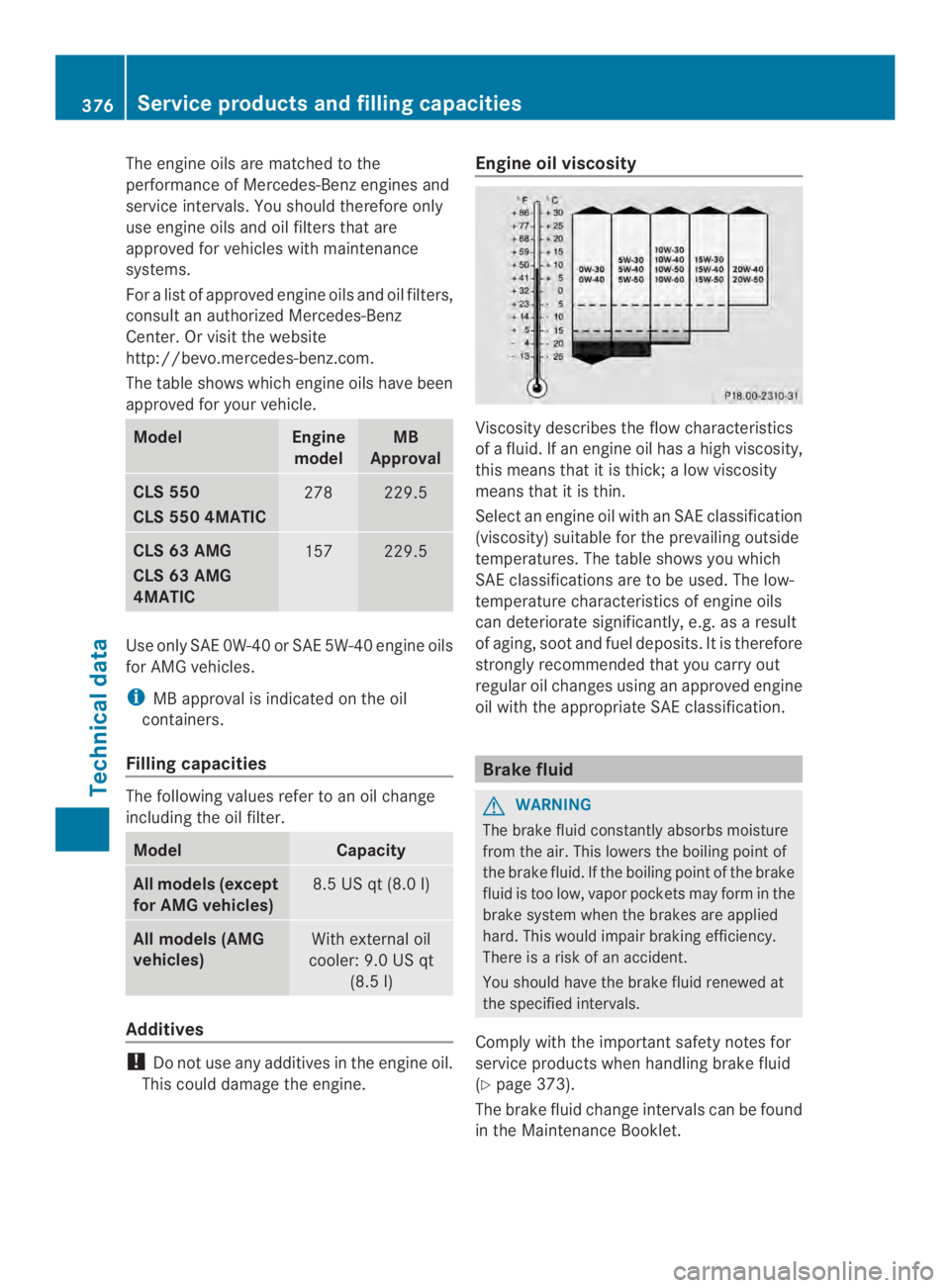Page 358 of 382

Curbweight
The weight ofavehicle with standard
equipment includingthemaximum capacity
of fuel, oil and coolant.Italso includes the air-
conditioningsystem and optional equipment
if these are installed in the vehicle, but does
not include passengers or luggage.
Maximumload rating
The maximum tireload is the maximum
permissible weight in kilograms or lbs for
whichatireisapproved.
Maximumpermissible tirepressure
Maximum permissible tirepressure for one
tire.
Maximumload on one tire
Maximum load on one tire. This is calculated
by dividingthe maximum axle load of one axle
by two.
PSI (pounds per squareinch)
Astandardunitofmeasure for tire pressure.
Aspect ratio
Relationship between tire height and tire
width in percent.
Tirepressure
This is pressure inside the tire applying an
outward forcetoeach square inch of the tire's
surface. The tire pressure is specified in
pounds per square inch (psi), in kilopascal
(kPa) or in bar. The tire pressure should only
be corrected when the tires are cold.
Cold tirepressure
The tires are cold:
Rif the vehicle has been parked without
direct sunlight on the tires for at least three
hours and
Rif the vehicle has been driven for less than
1mile (1.6 km).
Tread
The part of the tire that comes intocontact
with the road.
Bead
The tire bead ensures that the tire sits
securely on the wheel. There are several steel
wires in the bead to preventthe tire from
comingloose from the wheel rim.
Sidewall
The part of the tire between the tread and the
bead.
Weight of optional extras
The combined weight of those optional extras
that weigh more than the replaced standard
parts and more than 2.3 kilograms (5 lbs).
These optional extras, such as high-
performance brakes, level control,aroof rack
orahigh-performancebattery, are not
included in the curb weight and the weight of
the accessories.
TIN (Tire Identification Number)
This isaunique identifier which can be used
byatire manufacturer to identify tires, for
example foraproduct recall, and thus identify
the purchasers. The TIN is made up of the
manufacturer's identity code, tire size, tire
type code and the manufacturing date.
Load bearing index
The load bearing index (also load index) is a
code that contains the maximum load bearing
capacity ofatire.
Traction
Traction is the result of friction between the
tires and the road surface.
Treadwear indicators
Narrow bars (tread wear bars) that are
distributed over the tire tread. If the tire tread
is level with the bars, the wear limit of��in
(1.6 mm) has been reached.
356All about wheels and tires
Wheels and tires
Page 359 of 382

Occupant distribution
The distribution of occupantsinavehicleat
their designated seating positions.
Total load limit
Rated cargo and luggageloadplus
68 kilograms (150 lb) multiplied by the
number of seats in the vehicle.
Changingawheel
Flat tire
You can find information on whattodointhe
event ofaflat tire in the "Breakdown
assistance" section (Ypage 321).
Information on driving with MOExtended tires
in the event ofaflat tire can be found under
"MOExtended tires (tires with run-flat
characteristics" (Ypage 321).
Vehicle with emergency sparewheel:in
the event ofaflat tire, the emergencyspare
wheel is mounted as described under
"Mountingawheel" (Ypage 358).
Rotating the wheels
GWARNING
Interchangingthe front and rear wheels may
severely impair the driving characteristics if
the wheels or tires have different dimensions.
The wheel brakes or suspension components
may also be damaged. There isarisk of
accident.
Rotate front and rear wheels only if the wheels
and tires are of the same dimensions.
!On vehicles equipped withatire pressure
monitor, electronic components are
located in the wheel.
Tire-mounting tools should not be used
near the valve. This could damage the
electronic components.
Only have tires changed ataqualified
specialist workshop.
Always observe the instructions and safety
notes in the "Mountingawheel" section
(Ypage 358).
The wear patternsonthe front and rear tires
differ, depending on the operating conditions.
Rotate the wheels beforeaclear wear pattern
has formed on the tires. Front tires typically
wear more on the shoulders and the rear tires
in the center.
If your vehicle's tire configuration allows, you
can rotate the wheels according to the
intervals in the tire manufacturer's warranty
book in your vehicle documents. If this is not
available, the tires should then be replaced
every 3,000 to 6,000 miles (5,000 to
10,000 km), or earlier if the tire wear requires
this. Do not change the direction of wheel
rotation.
Cleanthe contact surfaces of the wheel and
the brake disc thoroughly every timeawheel
is interchanged. Check the tire pressure and,
if necessary, restart the tire pressure loss
warning system or the tire pressure monitor.
Direction of rotation
Tires withaspecified direction of rotation
have additional benefits, e.g. if there isarisk
of hydroplaning. You will only gain these
benefits if the correct direction of rotation is
maintained.
An arrow on the sidewall of the tire indicates
its correct direction of rotation.
Storing wheels
Storewheels that are not being used inacool,
dry and preferably dark place. Protect the
tires from oil, grease, gasoline and diesel.
Cleaningthe wheels
GWARNING
The water jet fromacircular jet nozzle (dirt
blasters) can cause invisible exterior damage
Changingawheel357
Wheels and tires
Z
Page 378 of 382

The engine oils are matched to the
performance of Mercedes-Benz engines and
service intervals. You should therefore only
use engine oils and oil filters that are
approved for vehicles with maintenance
systems.
Foralist of approved engine oils and oil filters,
consult an authorized Mercedes-Benz
Center. Or visit the website
http://bevo.mercedes-benz.com.
The table shows which engine oils have been
approved for your vehicle.
ModelEngine
model
MB
Approval
CLS 550
CLS 550 4MATIC
278229.5
CLS 63 AMG
CLS 63 AMG
4MATIC
157229.5
Use only SAE 0W-40orSAE 5W-40 engine oils
for AMG vehicles.
iMB approval is indicated on the oil
containers.
Fillingcapacities
The following values refer to an oil change
including the oil filter.
ModelCapacity
All models (except
for AMG vehicles)
8.5 US qt (8.0 l)
All models (AMG
vehicles)
With external oil
cooler: 9.0 US qt
(8.5 l)
Additives
!Do not use any additives in the engine oil.
This coulddamage the engine.
Engine oil viscosity
Viscosity describes the flow characteristics
ofafluid. If an engine oil hasahigh viscosity,
this means that it is thick;alow viscosity
means that it is thin.
Select an engine oil with an SAE classification
(viscosity) suitable for the prevailing outside
temperatures. The table showsyou which
SAE classifications are to be used. The low-
temperature characteristics of engine oils
can deteriorate significantly, e.g. asaresult
of aging, soot and fuel deposits. It is therefore
strongly recommendedthat you carry out
regular oil changes using an approved engine
oil with the appropriate SAE classification.
Brake fluid
GWARNING
The brake fluidconstantly absorbs moisture
from the air. This lowers the boiling point of
the brake fluid. If the boiling point of the brake
fluidistoo low,vaporpocketsmay form in the
brake system when the brakes are applied
hard. This would impair braking efficiency.
There isarisk of an accident.
You should have the brake fluid renewed at
the specified intervals.
Comply with the important safety notes for
service products when handling brake fluid
(Ypage 373).
The brake fluid change intervals can be found
in the Maintenance Booklet.
376Service products and filling capacities
Technical data